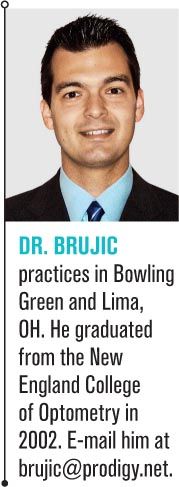What is the best contact lens for your patient?
We have been the fortunate recipients of innovative technologies in contact lenses that were only concepts a mere decade ago. As a profession, we transitioned most of our two-week and monthly disposable contact lens wearers who were in traditional hydrogel materials into silicone hydrogel materials.

We have been the fortunate recipients of innovative technologies in contact lenses that were only concepts a mere decade ago. As a profession, we transitioned most of our two-week and monthly disposable contact lens wearers who were in traditional hydrogel materials into silicone hydrogel materials. Not only are these changes in material, but also significant advances in design.
Additionally, there has been tremendous growth in the daily disposable modality. Several new materials and designs have created unprecedented comfort for many of our patients. Not only are those that are currently on the market remarkable technologies, but there are designs and materials that will continue to be brought to the market in our quest for more comfortable contact lens wear.
More contact lenses: Why you are your biggest obstacle to success
Now layer onto this the advances in toric and multifocal contact lenses, and you have set the stage for a remarkably powerful armamentarium of options with which fit our patients.

So with that said, why are we essentially seeing just as many patients dropping out of contact lenses as those beginning lens wear? With all of these advances, we would think that the number of contact lens wearers would have exponentially increased in particular over the last several years.
Are we asking the right questions?
Years ago, we attended a lecture where we heard someone say that the number one reason that patients dropped out of contact lens wear was discomfort. The lecturer stated that 50 percent of individuals who stopped wearing lenses said that discomfort was the number one reason. The lecturer then went on to say that approximately 50 percent of our current contact lens wearers are uncomfortable with their current lenses.
After the lecture, we asked each other what we thought, and each of us agreed that “It’s good information, but it doesn't really apply to us. Our contact lens wearers aren’t discontinuing wear at the rates that the lecturer discussed, and there is no way that 50 percent of our current contact lens wearers are uncomfortable in their current lenses.”
Boy, were we wrong!
More from Dr. Brujic: 3 reasons why lens care is still important
Shortly after that, we were both involved in a large clinical trial in which we were charged with recruiting uncomfortable contact lens wearers. We were having trouble recruiting for the study, so we just started having all of our lens wearers fill out the survey to see if they qualified. When they did, we realized very quickly how uncomfortable our seemingly comfortable contact lens wearers were.
This information has really changed the way that we view our current contact lens wearers. We find that most patients want to please their optometrist or may even be concerned that the fix to uncomfortable contact lenses is discontinuing lens wear. We realized that a simple question like, “How are your contact lenses doing?” lead to nothing more than the question, “How are you doing today?” The answer to both-regardless of what the true feeling is-is usually a standard “Good.”
Next: The challenge
The challenge
So, here is our challenge to you. Now, I wish I could take credit for this, but Dr. Fred Goldberg years ago shared this question to us that he asks all of his contact lens wearers: “At the beginning of the day, about five to 10 minutes after you place your lenses on your eyes, I want you to rank the comfort on a scale from zero to 10-with zero being the worst you can picture contact lenses feeling and 10 being the best. Now, using that same scale, I want you to rank your contact lens comfort about five to 10 minutes prior to removing your lenses in the evening.”
More contact lenses: New option for peroxide lens care case
What is interesting is that a number of seemingly happy lens wearers will respond with remarkably low numbers at the end of the day. So our challenge is for you to ask, following Dr. Goldberg’s example, your next 10 contact lens patients about their comfort. I am sure you will expose many opportunities for improvement in comfort.
Next: The opportunity
The opportunity
The unmet need in contact lens wearers is comfort. Think about new designs, materials, and modalities for your contact lens wearers. Don’t forget about optimizing the ocular surface. And when you ask yourself, “What is the best contact lens for my patient?” remember to first expose any comfort problems in your patients. When you do, you will want to try all of the new lens options and modalities to find out what optimizes your patients wearing experience.
More from Dr. Kading: Corneal size does matter in contact lens fit
And pay particular attention to the health of the ocular surface. When you do, you will offer your patients a significant improvement in lens wearing experience and will ultimately substantially positively impact your contact lens practice.